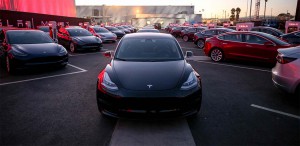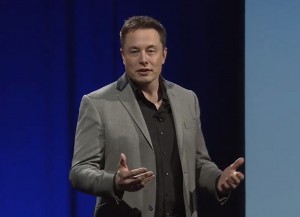
Tesla CEO Elon Musk said the company is still working on the bottlenecks that have hampered Model 3 production, crimping Tesla earnings.
When Tesla officially rolled the first of its new Model 3 sedans down the assembly line in mid-July it was billed as a historic moment. It was not only the California EV-maker’s first mainstream model, but also marked the first time Tesla had met its original production schedule, the previous launch of the Model X coming two years late.
Less than four months later, however, it’s clear that things haven’t been running as smoothly as Tesla and its CEO Elon Musk would like. The Model 3 line at the company’s Fremont, California, plant is barely moving, with workers frequently having to sub for stalled automation systems. That contributed to a record $619 million loss for the third quarter, the numbers far worse than even Wall Street’s increasingly pessimistic analysts had forecast.
But is this just a “flash in the pan,” as Tesla executives insisted during a Wednesday evening conference call, a temporary setback that will soon be overcome, or is it the sort of critical failure that could have a much longer impact on Tesla’s health?
The outspoken Musk was surprisingly subdued during a webcast scheduled to discuss the third-quarter earnings, officially blaming that on a cold, but clearly on the defensive after having to acknowledge Tesla’s recent troubles.
(Tesla takes a tumble: Q3 earnings fall well below expectations. For the story, Click Here.)
Musk tried to put a positive spin on the future by looking back at the past. Five years ago, he noted, Tesla had produced barely 2,500 vehicles since it set up shop. Now it’s 250,000 and, “I expect five years from now it will be at least an order of magnitude beyond where we are now.”

Tesla CEO Elon Musk has had to divert resources from other company projects to try to accelerate the production of the Model 3.
Indeed, Tesla was originally predicting production would hit as much as 500,000 next year, its Fremont plant pumping out 10,000 vehicles a week, at least three-quarters of them the new Model 3 sedan. But the third quarter saw a collective total of just 260 being built and while Musk didn’t offer hard numbers on what the build rate is now, he made it clear the company remains, as he warned earlier this year, in “production hell.”
After months of trouble-shooting, “We understand these bottlenecks,” but things have so far improved only slightly.
Several sources, as well as the trade site the Daily Kanban, have suggested that Tesla made a major mistake by installing the Model 3 assembly line before it had been fully tested by its designers. For his part, Musk admitted Tesla ultimately had to accept blame for its current problems. But he also pointed a finger at the unnamed supplier of software used to operate the first of four zones along the line, insisting the “subcontractor (had) really dropped the ball.” That forced the carmaker “to rewrite the software completely from scratch,” a process Musk said took 30 man-years of work in just four weeks.
That’s more troubling than it might seem. As Musk subsequently noted, much of Tesla’s engineering talent has had to divert attention from future projects, such as the compact Model Y electric SUV and a battery-powered semi-truck, to focus on the problems with the Model 3. That could translate into future product delays, among other things.
More immediately, it is far from clear how much the current problems in Fremont will delay the ramp-up of production on the new sedan that is supposed to turn Tesla into a mainstream automaker and transform years of losses into massive profits – Musk long promising profit margins would reach the unprecedented level of 25% or more.
The software problem may be resolved, but the CEO and his top management team revealed that there remain scores of other bottlenecks to break, primarily on the first half of the new line. Even so, Musk declared confidence that production will reach 5,000 a week by “late in the first quarter, in March.” Or will it? In a question-and-answer session, he subsequently warned there are “too many uncertainties” to predict the ramp-up pace at this point.
(To see why Tesla raised an additional $500M in cash, Click Here.)
Perhaps more significant was the warning sounded by Tesla Chief Financial Officer Deepak Ahuja that the company is not sure when it will make the next big capital investment to double the capacity of the plant’s Model 3 assembly line. Without that the carmaker won’t be able to come close to the 500,000 annual production target.
That could be a major problem, as Wall Street investment firm UBS cautioned in a report this week. Tesla currently has more than 400,000 advance reservations for the Model 3, but how long potential buyers will wait to take delivery is uncertain – all the more so UBS analysts wrote, because “competing EVs are coming, and a long delay could reduce (Tesla’s) market share opportunity.” One warning sign comes with the explosive growth of Chevrolet Bolt EV sales in recent weeks. Some observers believe the Chevy model has been picking up customers who have begun writing off Tesla.
Wall Street has long embraced Tesla, its stock hitting a mindboggling $385-a-share peak during the summer. But a growing number of analysts are now turning bearish.
“Tesla needs to slow down and more narrowly focus its vision and come up for a breath of fresh air,” said a note from Cowen and Co. after the third-quarter earnings were released. “Elon Musk needs to stop over promising and under delivering.”
Complicating concerns, while CFO Ahuja said the delay in funding the rest of the Model 3 line was simply prudent financial control, he did not fully rule out the need for Tesla to again go back to the well, as it did earlier this year, to raise more capital.
“While we expect that increased Model 3 production will provide a meaningful injection of liquidity on a number of fronts, Tesla runs the risk of requiring financing over the next few quarters, particularly if Model 3 production continues to undershoot expectations,” Nomura Instinet analyst Romit Shah said in his own analysis.
Tesla is by no means the only automaker to run into launch problems with a major new product. But the Model 3 is its first mainstream offering and it comes to market at a time when Tesla’s cash reserves are strained and as competitors are determined to challenge it in the emerging electric vehicle segment.
(Click Here for details about protests over Tesla plant firings.)
As both Ahuja and Musk stressed, the current problems could be just “a flash in the pan,” and largely forgotten two years from now if Tesla can meet the ambitious promises set for the Model 3. But if the production problems continue to drag on, Tesla’s future is far less certain.
